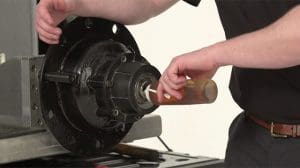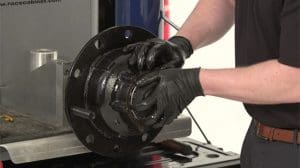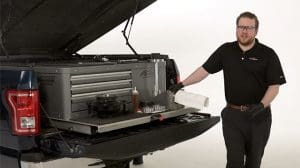Étape 1 : Déterminez si le véhicule a besoin de King Pins
Fixez l'indicateur à cadran monté magnétique sur le dessus de l'essieu avec l'indicateur à cadran reposant sur l'œil de la broche pour vérifier le mouvement horizontal.
Avec l'extrémité de la roue et le pneu intacts, placez un levier sous le pneu et soulevez le pneu de haut en bas tout en mesurant la quantité de balancement de l'aiguille dans le comparateur à cadran.
S'il y a un mouvement de 0,010" ou plus, le pivot d'attelage doit être remplacé.
Étape 2 : Démontez l'extrémité de la roue et les pivots d'attelage
Retirez la roue. Retirez l'ensemble de frein et la plaque d'appui.
Retirez les bras de direction et la barre transversale.
Retirez les plaques supérieure et inférieure du pivot d’attelage.
Retirez les goupilles de verrouillage. (utilisez du punch durci – n’utilisez pas de chaleur)
Retirez le pivot d'attelage. Utilisez une presse hydraulique ou un cric-bouteille. (ne pas utiliser de chaleur).
Conservez les cales pour référence ultérieure.
Retirez la broche et répétez le processus du côté opposé du camion.
Nettoyer les œillets et les axes d'essieu pour inspection.
Étape 3 : Retirez les bagues et les joints du King Pin
À l'aide d'un tourne-bague STEMCO Kaiser de la série « ST » et d'un marteau en laiton ou d'un marteau à coup mort, martelez les bagues hors des œillets de broche.
La bague fera sortir le joint le cas échéant.
N'utilisez pas de poinçon ou de burin. Cela pourrait entraîner un endommagement irréparable des œillets de broche.
Étape 4 : Inspectez les composants
Évaluez l’œil de l’essieu pour déterminer s’il est déformé.
Les kits K122E et 70.122.05 sont livrés avec une jauge No-Go et le conseil technique #100 qui explique la procédure.
Évaluez les yeux de la broche pour déterminer s’ils sont déformés.
Utilisez un micromètre et une jauge en T pour déterminer s'ils répondent aux spécifications
Étape 5 : Affûtez les yeux de l'essieu et de la broche
Utilisez un affûteur de frein dans une perceuse à main pour affûter légèrement l'œil de l'essieu jusqu'à ce qu'il soit lisse.
Ne pas trop affiner. Nettoyez simplement cette surface.
Étape 6 Installez le joint et la bague QwikKit
Utilisez un pilote de bague STEMCO Kaiser de la série « ST » (pièce # ST70-7 si axe 12k)
Installez le joint à l'extrémité de l'entraîneur avec le bord biseauté du joint tourné vers l'extérieur.
Utilisez un marteau en laiton ou un marteau à coup mort pour marteler le joint dans l'œil de la broche jusqu'à ce que le tournevis affleure le bas de l'œil de la broche. Supprimez le pilote. (Pour les conseils d'installation du joint à lèvre, voir l'astuce technique # 01 577 0036)
Tenez la bague en acier en spirale dans la main, légèrement inclinée, et tournez la bague en spirale dans l'œil de la broche en tournant la bague dans le sens des aiguilles d'une montre.
Installez-le aussi loin que possible à la main, puis utilisez un outil à poignée en T (généralement ST100-1) pour le visser. Enfoncez la quantité restante de la bague dans la broche jusqu'à ce qu'elle affleure avec un marteau en laiton.
Étape 7 Terminer l'installation de QwikKit
Placez le pivot d'attelage dans l'alésage supérieur pour vérifier l'ajustement. Répétez la procédure sur l’alésage inférieur.
Faites glisser la goupille dans les deux alésages pour tester l’alignement de la broche. Si le pivot d'attelage ne rentre pas dans l'œil de la broche opposée, la broche à œil doit être remplacée.
Comptez les cales que vous avez retirées des anciens pivots. Vous les utiliserez pour déterminer combien il faut remettre en place. Déterminez l'épaisseur de la pile de cales précédente et commencez par ajouter 0,005" de plus que ce que vous avez retiré comme point de départ. Par exemple, si vous avez retiré une pile de cales de 0,020" d'épaisseur, remplacez-les par 0,025" d'épaisseur. Les cales sont disponibles en épaisseurs de 0,005" et 0,010". Vous pourrez déterminer la différence par la sensation.
Emballer le roulement avec de la graisse avant l'installation. (Conseil technique # 577 0033 Informations sur les roulements)
Avec le mot « TOP » sur le dessus du pivot d'attelage orienté vers l'extrémité du
broche, placez le pivot d'attelage dans l'œil supérieur de la broche et faites-le glisser jusqu'à ce que ½ pouce de la goupille sorte du bas.
Pour faciliter l'installation (et les doigts cassés), pliez la dernière cale du paquet et placez les cales sur le pivot d'attelage.
Soulevez la broche et placez-la sur l'essieu, et laissez le pivot d'attelage tomber dans le trou.
Poussez le pivot d’attelage vers le bas jusqu’à ce qu’il affleure le bas de l’essieu.
À l’aide de la paume de votre main, installez le roulement avec le côté ouvert vers le bas. Si vous ne pouvez pas installer le roulement avec la paume de votre main, démontez l'assemblage et retirez 0,005" des cales.
Si vous pouvez le mettre en place avec vos doigts, démontez l'assemblage et ajoutez une cale supplémentaire de 0,005" à la pile.
Installez le(s) verrou(s). Assurez-vous que le côté plat de la goupille de verrouillage fait face au pivot d'attelage.
Installez les écrous et les rondelles et serrez. La spécification de couple est généralement de 30 à 45 pi-lb.
Installez les plaques supérieure et inférieure et serrez.
Étape 8 Ajouter de la graisse
Fixez le pistolet graisseur au raccord Zerk supérieur. Tout en pompant de la graisse dans le raccord, déplacez la broche d'un côté à l'autre jusqu'à ce que la graisse sorte entre la broche et l'essieu. Si la broche ne bouge pas correctement, soit il y a trop de cales installées, soit vous avez peut-être endommagé le roulement.
Fixez le pistolet graisseur au raccord Zerk inférieur. Tout en pompant de la graisse dans le raccord, déplacez la broche d'un côté à l'autre jusqu'à ce que la graisse sorte par le haut du roulement.
Note du technicien : QwikKit contient plus de 2 fois la graisse de n'importe quel concurrent. Si vous n'insérez pas de graisse supplémentaire et ne travaillez pas dans la conception de la bague/goupille (A et B ci-dessus), le véhicule se dirigera de manière « rigide » jusqu'à ce que la graisse ait pu pénétrer dans les rainures.
Étape 9 Terminez le remontage
Réinstallez les bras de direction et la barre transversale.
Réinstallez l’ensemble de frein et la plaque d’appui. Réinstallez la roue.
Étape 10 Vérifiez votre travail
Fixez l'indicateur à cadran monté magnétique au sommet de l'essieu avec le cadran
indicateur reposant sur l'oeil de broche.
Avec l'extrémité de la roue et le pneu intacts, placez un levier sous le pneu et soulevez le pneu de haut en bas tout en mesurant la quantité de balancement de l'aiguille dans le comparateur à cadran. (Le mouvement doit être minime)
Remarque : Il existe de nombreuses variantes de pivots d'attelage. Les instructions ci-dessus décrivent une procédure générale pour l’installation du pivot d’attelage. Il peut être nécessaire d'adapter ces instructions au jeu de pivots d'attelage particulier que vous installez.






